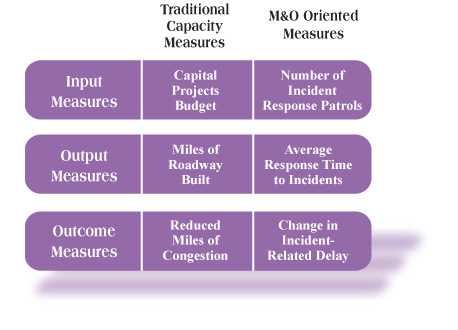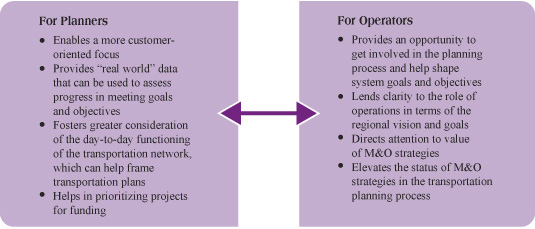Getting More by Working Together — Opportunities for Linking Planning and Operations2. Opportunities for Linking Planning and Operations2.3 Performance MeasuresBACKGROUND"What gets measured gets managed." This often-repeated maxim recognizes that performance measurement can focus the attention of decisionmakers, practitioners, and the public. By focusing attention on the operating performance of the transportation system, performance measures serve as an important mechanism for increasing awareness of management and operations approaches within the planning process. Performance measures provide a means to link a transportation agency's perspective with the experience of those who use the transportation system. The act of defining performance measures and tracking performance often requires communication and coordination between those who manage operations for the transportation system and those involved with planning and policy development. Those who manage operations often have data and expertise on real-time system performance. Planners and policymakers can use this information in order to set goals, track progress, and make investment decisions. What Is Performance Measurement?Performance measurement is a process of assessing progress toward achieving predetermined goals, including information on the efficiency with which resources are transformed into goods and services, the quality of those outputs (how well they are delivered to clients and the extent to which clients are satisfied) and outcomes (the results of a program activity compared to its intended purpose), and the effectiveness of government operations in terms of their specific contributions to program objectives.10 Performance measures have many functions. They can be used to:
Performance measures can be grouped into three categories (See Exhibit 5 for examples):
Exhibit 5: Classes of Performance Measures 
While input and output measures are the easiest to implement, outcome measures focus on the effects that the traveling public most cares about – issues such as travel time and delay, safety, and reliability. Increasingly, MPOs, transit operators, and DOTs are becoming customer-focused, which increases attention to the development of outcome measures. Still, outcome-oriented performance measurement is minimally practiced in many regions. A survey of MPOs asked, "Does your planning process reflect measurements of actual system performance, like travel time, reliability, and incidence of non-recurring congestion?" Of those that responded, 45 percent answered no.11 How Can Performance Measurement Create Stronger Linkages Between Planning and Operations?Performance measures can help link planning and operations by focusing attention on customer-oriented outcomes and elevating attention to M&O strategies within the transportation planning process. Increased coordination and collaboration among operations and planning staff can also help instill operations thinking into policy and planning decisions. Outcomes are beneficial for both planners and operators, as shown in Exhibit 6. Exhibit 6: Benefits of Collaboration for Performance Measures 
Key ways in which performance measures strengthen such collaboration are described below. Performance Measures Bring Focus to Customer-Oriented OutcomesPerformance measurement has traditionally been in the realm of planners and policy analysts as part of the planning and investment prioritization process. Metrics tended to be those that can be modeled and used for long-term investment decisionmaking, such as average travel times and miles of congested roadways.
Increasingly, transportation agencies are moving toward a customer-oriented focus and want to develop performance measures that reflect what is most important to transportation system users (see Case 10). Examples of performance measures that focus on management and operations include:
By addressing issues that are important to transportation system users, performance measures can focus help attention on management and operations where the experience of transportation system users is considered in a more immediate sense. Thus, the process of developing and implementing effective performance measures can motivate collaboration between transportation operations and planning staffs. Moreover, advances in ITS and real-time monitoring of traffic mean that operators have access to an incredible depth of traffic data that can be used to measure more accurately the real traffic conditions experienced by users. This information brings to light a range of issues, such as incident-related delay and reliability, which are important customer issues but have not traditionally been included as performance measures. Performance Measures Elevate the Status of M&O ApproachesEfforts to focus on system performance often result in better recognition of the value associated with M&O approaches. Data on system performance can highlight the value of investments in programs that minimize incident-related delays, provide information on real-time travel conditions, and improve emergency response times by showing how they can improve transportation system reliability and reduce travel times for customers. The limited number of tools to quantify the benefits of operational strategies is often noted as a constraint in bringing greater attention to M&O strategies. However, there is a growing number of tools on the market today to predict the effects of operational strategies on system performance. (See Exhibit 7 for examples of several tools.) Some agencies also have found success in measuring performance before and after implementation of operations-oriented projects. Given increased traffic congestion, limited road space, and funding constraints, public decisionmakers in many areas recognize the limitations associated with constructing new transportation infrastructure to meet regional transportation goals. Use of performance measures and measurement of the benefits of M&O strategies, can help these decisionmakers to appreciate the value of M&O approaches toward meeting both short-term and long-term goals (see Case 11). Performance Measures Help Inform Policy DecisionsBy focusing attention on system characteristics that are important to the traveling public, performance measures can help planners focus on the day-to-day experience of transportation system users. This provides important balance in settings where planners have been exclusively focused on very long-term development of the network. With greater focus on the day-to-day characteristics of the system, the issues faced by operators such as incident response, work zone management, and provision of traveler information take on greater importance. As a consequence, mid- and long-term planning will reflect greater consideration of management and operations planning and investment needs. Greater understanding of operations issues by planning staff can also help in setting transportation policies. TAKING ADVANTAGE OF LINKAGE OPPORTUNITIESThere are a number of opportunities to use performance measurement to build stronger linkages between planning and operations. Following are some ways to take advantage of performance measures in this way. Involve Operations Managers in the Process of Developing Performance MeasuresAgencies responsible for major investment decisions often take the lead in developing performance measures. However, it is critical that this process involve practitioners who are concerned primarily with day-to-day operation of the transportation system. The operator's perspective relates closely to near-term concerns of the traveling public. Though operations practitioners have clear expertise to contribute the performance measure development, a focused effort may be required to ensure that they understand the importance of their involvement in the process and the importance of performance measures being supportive of regional goals. Incorporate Operational Performance Measures Into Strategic and Long-Range Transportation Plan (LRTP)Performance measures in the LRTP should be driven by the goals and objectives of the plan, which in turn, should reflect the region's vision for its transportation system. Customers (including the general public, freight shippers, and others) are increasingly concerned about operational performance of the transportation system, including the reliability of the system and the availability of information about travel conditions that can inform the best travel time, mode, and route (see Case 12). Incorporating operational performance measures into the LRTP provides an avenue for operators and customers (through public involvement) to get involved in the planning process. It can provide better information to customers and stakeholders on the progress being made toward desired goals and objectives, and can, therefore, serve to make long-range plans more real to the public. Moreover, incorporating performance measures helps to ensure that regional transportation system management and operations programs receive adequate attention in prioritization of projects for funding. Use Operations Data for Tracking Performance in Annual or Quarterly ReportsPeriodic performance reports provide an excellent mechanism to make planning more relevant to everyday experience. A number of MPOs, transit operators, and State DOTs use performance reports to inform decisionmakers about the trends in system performance. Such reports work as a linkage in a number of ways:
Agencies that report performance measures in a quarterly or annual performance report encourage a sustained communications link between planning and operations staffs. Even a very simple report providing one or two performance measures can have a positive effect in broadening the discussion over investment priorities. There are many cases where a particular activity or project requires temporary coordination or exchange between planners and operators, but sustaining such communication is critical for changing the everyday perspective of these departments to routinely consider operations tools within the planning process. Routine, sustained, performance reporting is, therefore, particularly valuable (see Case 13). Use Performance Measures to Motivate Data and Tool DevelopmentGiven the rapid evolution of automated travel data collection technology, it is helpful to discuss performance measures beyond those that are supported by current capabilities. As one element of a performance measurement effort, transportation agencies within a region may jointly wish to define the most appropriate measures and associated data needs, without allowing current resources to limit the discussion. This can be used to establish goals for data collection and measurement and to provide some focus in reviewing the stream of evolving transportation information technologies. LESSONS LEARNEDThe very characteristics that make performance measurement a useful linkage between planning and operations can also make performance measurement a complex challenge. The process often demands new data and tools and may require new levels of coordination between agencies or departments. The following lessons have emerged from agencies that have faced such challenges. Begin With Simple Output MeasuresSome regions focus on output measures, which are often simpler than outcome measures. For example, the Maricopa Association of Governments performance measures include the number of signals coordinated and the percentage of cross-border signals coordinated between cities. While not specifically related to the customer, such measures can still succeed in increasing policy and investment focus on the region's M&O progress. Output measures are particularly effective where there is already some appreciation among local decisionmakers for the value of M&O solutions. Using simpler output performance reporting can inspire the attention and collaboration necessary to design measures that address the most important aspects of the system performance. Do Not Expect a Clean and Simple ProcessDefining performance measures takes time and may not yield immediate, refined outputs. This is particularly the case when the process is working to attract a broader audience. When new stakeholders and perspectives are drawn to participate, the process becomes more complex; deciding on concrete characteristics to measure raises difficult questions about the fundamental objectives served by the transportation network. Agencies should approach performance measurement with awareness that the effort will be a challenge. Initial performance measures may not be perfect, but initial steps are apt to attract greater interest and advance the effort. 10 Performance Measures of Operational Effectiveness for Highway Segments and Systems - A Synthesis of Highway Practice, NCHRP Synthesis 311, Transportation Research Board; Washington, DC, 2003. 11 Survey of MPOs on Linking Planning and Operations, Association of Metropolitan Planning Organizations, January 2004.
|
| US DOT Home | FHWA Home | Operations Home | Disclaimer | ||